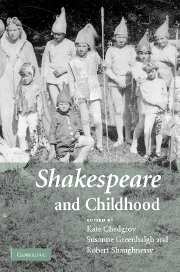Book contents
- Frontmatter
- Contents
- Acknowledgements
- Notes on contributors
- Note on the text
- 1 Introduction
- PART 1 SHAKESPEARE'S CHILDREN
- 2 Introduction: ‘What, are they children?’
- 3 Little princes: Shakespeare's royal children
- 4 Father-child identification, loss and gender in Shakespeare's plays
- 5 Character building: Shakespeare's children in context
- 6 Coriolanus and the little eyases: the boyhood of Shakespeare's hero
- 7 Procreation, child-loss and the gendering of the sonnet
- PART 2 CHILDREN'S SHAKESPEARES
- APPENDICES
- Index
5 - Character building: Shakespeare's children in context
Published online by Cambridge University Press: 22 September 2009
- Frontmatter
- Contents
- Acknowledgements
- Notes on contributors
- Note on the text
- 1 Introduction
- PART 1 SHAKESPEARE'S CHILDREN
- 2 Introduction: ‘What, are they children?’
- 3 Little princes: Shakespeare's royal children
- 4 Father-child identification, loss and gender in Shakespeare's plays
- 5 Character building: Shakespeare's children in context
- 6 Coriolanus and the little eyases: the boyhood of Shakespeare's hero
- 7 Procreation, child-loss and the gendering of the sonnet
- PART 2 CHILDREN'S SHAKESPEARES
- APPENDICES
- Index
Summary
If we broadly define culture in terms of what is learnt and shared, then children as carriers of culture, and childhood where so much learning occurs, must be seen as crucial to the reproduction of culture.
When Shakespeare examines the experience of children and childhood in his plays, he aligns his child and his young adult characters specifically and deliberately with ideas about textuality and history, showing them engaging directly with certain significant books and with ideas about the processes of history. The idea that formation of character and induction into an understanding of society is as much a product of text, of story, of history, as it is of experience is thereby made explicit. The fact that all the Shakespearean characters treated in this way are boys, and that only boys were formally educated in the Tudor system, where girls were not, lends further weight to this approach. What is the dramatic significance of the relationship between school texts, texts of formation, the process of history and the child figure in Shakespeare? How does this Shakespearean pedagogy construct masculine childhood as the site for the making of the early modern performative textual self?
I want, in this chapter, to suggest two ways of reading the dramatic function of these child characters.
- Type
- Chapter
- Information
- Shakespeare and Childhood , pp. 64 - 79Publisher: Cambridge University PressPrint publication year: 2007
- 4
- Cited by

